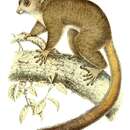Biology
provided by Arkive
Coquerel's mouse lemur is nocturnal, and active all year round. This tiny primate is arboreal, and feeds on fruit, flowers and gums, as well as small animal prey such as insects, spiders, frogs, lizards, small birds, and eggs. During the dry season it also feeds on sweet secretions of homopteran larvae to supplement its diet. Interestingly, most activity is carried out alone. Gum sites and animal prey can only be fed on by one animal at a time, which necessitates solo feeding. To facilitate its ability to forage at night, this animal's night vision is improved by a layer of light reflecting crystals behind the retina: a common adaptation in nocturnal animals (4).
This species is well adapted for its nocturnal lifestyle. They feed in the dark to avoid being seen by predators such as birds, and are careful not to be seen or heard. They communicate and coordinate activities using acoustic and olfactory signals, including ultrasound. By day they hide in spherical nests constructed from interwoven vines, twigs and leaves (2). The use of these nests reveals that this species' social relationships are complex as individual adults sleep alone, though adult females occasionally sleep in pairs (4).
Females occupy home ranges that overlap with those of close relatives and, as with many mammals, males have home ranges that are larger than those of the females, especially during the breeding season. Recent research has revealed the breeding season is in October, during which the males' testes become dramatically enlarged. Male individuals also emit a shrill call as part of the mating display and females advertise their onset of oestrous with loud calls. These factors, coupled with the increase in a male's home range size during breeding season, indicate that competition between males for females is intense, and that this species is promiscuous (2) (4). The gestation period lasts for 86 to 89 days, and one to four (usually two) young are born in a nest (5). Even after juveniles leave their mother, they remain in contact with vocal calls for some time (4). Sexual maturity is reached after 18 months and, in healthy forests, populations can breed successfully, producing densities of up to 385 individuals per km² (2).
Conservation
provided by Arkive
This species occurs in a number of protected areas in Madagascar, though surveys are required to assess the population numbers within them. Captive breeding programmes have also been established at a number of zoos and related institutions and provide potential for re-introduction programmes in the future. Madagascar has one of the highest levels of endemic biodiversity in the world and it is hoped that habitat protection of its habitat in the future will help to save vulnerable wildlife like the Coquerel's mouse lemur (1) (2).
Description
provided by Arkive
The Coquerel's mouse lemur is a relatively small primate from Madagascar, with a body size of only 20 to 25 centimetres (2). The body is an olive brown colour with yellowish grey underparts (3). The head is small with beady dark eyes, a moist muzzle and long hairless ears. It has an elongated body with short arms and legs, and runs and jumps quadrupedally through the trees, using its long and fairly bushy tail for balance. Males and females are similar in appearance, though females are slightly larger in size than males. Females are identified by the presence of two pairs of mammary glands, and males by their relatively large testicles, which exceed the brain in both volume and mass (4).
Habitat
provided by Arkive
Inhabits thick, dry deciduous forests on the coast, or near rivers or ponds, where it is usually found 1-6 meters above the ground (3).
Range
provided by Arkive
This species is endemic to Madagascar where it is found on the western coast of the island (3).
Status
provided by Arkive
Classified as Vulnerable (VU A2cd, B1+2abc) on the IUCN Red List 2003 (1).
Threats
provided by Arkive
This species is predated on by nocturnal raptors such as owls, which may take up to 30% of the Coquerel's mouse lemur's population in a year (4). Over the past several decades, however, a greater threat to the future of this species has emerged. Forest destruction due to cultivation, logging, development and fires has dramatically reduced suitable habitat for much of Madagascar's wildlife, including that of this species (6). Research suggests that this lemur may be able to adapt to secondary forest, which may help it survive the partial destruction of its natural habitat. However, its range in Madagascar is limited and individual's home ranges are becoming increasingly fragmented and may reduce their breeding potential (1) (2).
Coquerel's giant mouse lemur: Brief Summary
provided by wikipedia EN
Coquerel's giant mouse lemur (Mirza coquereli), also known as Coquerel's dwarf lemur or the southern giant mouse lemur, is a small nocturnal lemur endemic to Madagascar. This species can be found in parts of the Madagascar dry deciduous forests.
- license
- cc-by-sa-3.0
- copyright
- Wikipedia authors and editors

